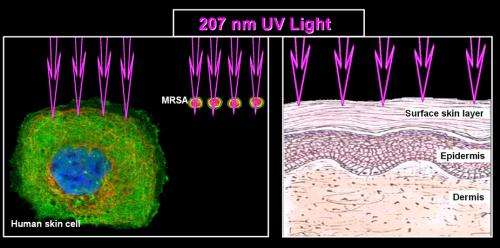Narrow-spectrum UV light may reduce surgical infections

Despite major efforts to keep operating rooms sterile, surgical wound infections remain a serious and stubborn problem, killing up to 8,200 patients a year in the U.S. A study by Columbia University Medical Center (CUMC) researchers suggests that narrow-spectrum ultraviolet (UV) light could dramatically reduce such infections without damaging human tissue. The study, conducted in tissue culture, was published today in the journal PLOS ONE.
Approximately 200,000 to 300,000 patients suffer surgical wound infections in the U.S. each year, accounting for $3 billion to $10 billion in health-care expenditures, the researchers report. Patients with surgical wound infections, compared with those without such infections, are 60 percent more likely to spend time in an ICU, are five times as likely to be readmitted to the hospital, have twice the mortality rate, have longer hospital stays, and have roughly double the total health-care costs.
Scientists have known for many years that UV light from a standard germicidal lamp (which emits a broad spectrum of wavelengths, from about 200 to 400 nanometers [nm]) is highly effective at killing bacteria; such lamps are routinely used to decontaminate surgical equipment.
"Unfortunately, this UV light is also harmful to human tissue and can lead to skin cancer and cataracts in the eye," said study leader David J. Brenner, PhD, the Higgins Professor of Radiation Biophysics, professor of environmental health sciences, and director of the Center for Radiological Research at CUMC. "UV light is almost never used in the operating room during surgery, as these health hazards necessitate the use of cumbersome protective equipment for both surgical staff and patients."
Dr. Brenner and his team hypothesized that a very narrow spectrum of UV light—around 207 nm—might be capable of destroying bacteria while leaving human tissue unaffected. Because UV light at this wavelength is strongly absorbed by proteins, it is expected to be safe for two reasons: At the cellular level, it cannot reach the nucleus of human cells, and at the tissue level it cannot reach the sensitive cells in the skin epidermis and the eye lens. But because bacteria are much smaller than human cells, this UV light can reach their DNA. "What this means is, if you shone 207-nm light on human skin or eyes, you would not expect to see any biological damage," said Dr. Brenner, "but it should kill any airborne bacteria that land on a surgical wound."
To test this hypothesis, Dr. Brenner and his colleagues exposed MRSA (methicillin-resistant S. aureus) bacteria, a common cause of surgical wound infections, and human skin cells to a krypton-bromine excimer lamp (also known as a KrBr excilamp), which emits UV light only at 207 nm, as well as to a standard germicidal UV lamp.
The researchers found that 207-nm UV light was as effective at killing MRSA bacteria as a conventional UV lamp. However, the 207-nm light resulted in 1,000-fold less killing of human skin cells than did the standard UV light.
In another experiment, the researchers tested the two UV lamps on a standard tissue-culture model of human skin (which includes the major skin layers, the epidermis and dermis). Exposure to a standard UV lamp caused extensive precancerous changes in the epidermis, while exposure to the same level of 207-nm light did not.
"Our results to date suggest that 207-nm UV light may be an effective add-on to current infection-control measures, without the need for protective equipment for staff or patients," said Dr. Brenner. "We need all the tools we can get to reduce surgical wound infections, especially those involving drug-resistant strains of bacteria, which have become increasingly common."
According to Dr. Brenner, a main route to surgical infection is through the air. "Despite every possible effort to promote sterility, MRSA and other bacteria are essentially raining down on the wound during the entire surgery," he said. "If this UV lamp were continuously shone on the wound during surgery, the bacteria would be killed as they landed." The lamps, known as excimer lamps, are small, rugged, inexpensive, and long-lived, the researchers noted.
"These findings have important clinical significance for mitigating surgical infections," said K.S. Clifford Chao, MD, the Chu H. Chang Professor of Radiation Oncology and chair of radiation oncology at CUMC and professor and chair of radiation oncology at Weill Cornell Medical College. "Right now, incidental infections occur unexpectedly. But with the use of narrow-spectrum UV light, surgical care may be improved at an affordable cost."
The researchers are now conducting in vivo tests of the 207-nm lamp.
More information: The paper is titled, "207-nm UV Light—A Promising Tool for Safe Low-Cost Reduction of Surgical Site Infections. I: In-Vitro Studies."




















